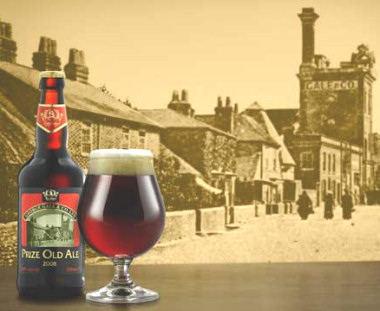 |

|
|

|
|
|
 |

home
about
features
A-Z
books

|

|

Protz:
features
reviews
tastings
|

| |
Gale's Prize Old Ale
by Willard Clarke, 04/10
| Gale's Prize Old Ale (POA) is alive and well. The celebrated bottle-conditioned old ale, first brewed in the 1920s, seemed certain to disappear when the brewery in Horndean,
Hampshire, was taken over by Fuller's in 2006. As Fuller's, based in Chiswick, west London, has two bottle-matured beers, 1845 and Vintage Ale, POA looked surplus to requirements.
But the beer, often described as Britain's version of Belgian lambic, has survived. Fuller's has produced two vintages, dated 2007 and 2008.
|
|
 |
The first was produced at Gale's prior to the closure, the second at Chiswick. An exceptionally large batch was made at Gale's and some of this is now used for blending at Fuller's to ensure the beer retains its tart and slightly sour characteristics.
the Prize Old Ale story
POA was the result of a brewer from Yorkshire going to work in Horndean in the 1920s and bringing with him the recipe for a strong and long-matured old ale.
 |
|
For decades the beer was fermented in wooden vessels then matured in hogsheads for six to 12 months. Natural bacteria in the wood gave the beer its sharp, lactic tang.
Eventually the hogsheads were phased out and replaced by metal tanks but the lactic character was retained by blending new beer with a batch of old. Yeast used for primary
fermentation was added in bottle, sealed with corks and cradles. The beer was declared at 9% but could reach as high as 12% with bottle conditioning. POA was
brewed with Maris Otter pale malt with black malt and brewing sugar. The hops were Fuggles and East Kent Goldings (colour 90 units, bitterness units 53).
|
John Keeling, Fuller's head brewer, is enthralled by the manner in which POA develops. "It's not lambic - but it's similar," he says. "At Gale's, where it was fermented in wood, it acquired a unique flora and fauna character as the vessels were impossible to clean properly. It was a completely wild system and the natural micro-organisms gave the beer its unique quality. Even though it was stored in stainless steel tanks, it didn't lose the flora and fauna notes."
The base beer brewed by Fuller's for blending is now made with Optic pale malt, with crystal and chocolate malts. The hops are still Fuggles and Goldings as their peppery and spicy notes are vital contributors to the beer's aroma and palate.
John Keeling said each new vintage of POA is a blend of new beer and a proportion of the old Gale's stock. The beer is matured for 12 months in metal tanks and is then blended
again with fresh beer. "Each vintage is vatted for 18 months," he says, "which allows the micro-organisms to do their work. We will always brew too much and hold some
back and we will always have a percentage of the old Gale's beer. The wood supplied the micro-organisms and we will keep them alive even though the beer is now aged in
stainless steel tanks. It's the combination of yeast and bacteria that gives the beer its character."
| Nevertheless the 2008 version of POA is radically different to the 207. John Keeling is quite open about the reasons for the difference. "Our sales team didn't want to sell the 2007 vintage - they said it wasn't commercially viable, just too sour for most drinkers. But John Roberts, our managing director, was keen to continue with the beer. He said a wider audience was needed.
The beer now comes with a conventional crown cork. "The driven cork was part of the problem," Keeling says, "as the beer tended to be flat. The new cork retains more natural carbonation."
I tasted 2007 and 2008 together. The 2007 vintage has a ruby colour and a massive nose of glac� fruit, raisins, sultanas and Dundee cake. It's mouth-puckeringly tart in the mouth, fruity and refreshing, with peppery hops and tart fruit in the finish.
The 2008 is less aggressively sour. The colour is identical and the nose has raisins, sultanas, walnuts with barley sugar, a hint of chocolate and warming alcohol in the mouth. Sourness comes through in the finish, with peppery Goldings and tart fruit.
|
|
 |
Fuller's is selling more POA than Gale's and future vintages may restore some of the more aggressive tartness of the past. I agree with Jeff Evans in the Good Bottled Beer Guide that the 2008 vintage has more in common with a sour red Rodenbach than a lambic. The beer is available only from Fuller's online shop: fullers.co.uk.
The Fuller's sales team had no doubts about a new beer: an India Pale Ale called Bengal Lancer. It's been a runaway success and sold out within days of being launched. A new batch was ready for bottling at the end of March but the beer will not be available in cask again until September.
The beer is 5.3% in bottle (5% in cask) and is bottle-fermented. It's brewed with pale and crystal malts, hopped with Fuggles and Goldings and dry hopped in tank with Goldings and Target. It has between 45 and 50 units of bitterness. It has an enticing aroma of tangy citrus fruit, biscuity malt and peppery hops, with hop bitterness building in the mouth. The finish is long and quenching, beautifully balanced between spicy and resinous hops, tart fruit and juicy malt. The beer is on sale in Fuller's pubs as well as from the online shop.
| *A new version of Fuller's Reserve, the beer aged in wood, will be bottled in either May or June. The first version was matured in malt whisky casks but the new one will be aged in Courvoisier barriques
|
|
|
home
about
features
A-Z
books
|

